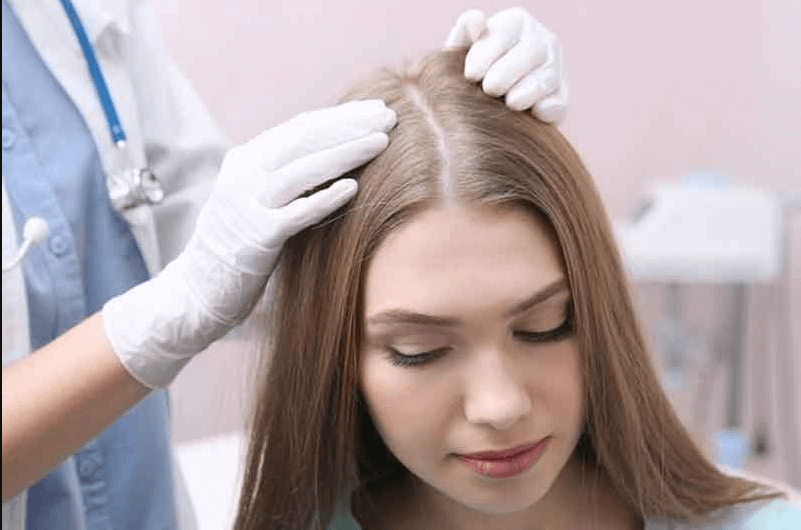Hair loss affects all kinds of people regardless of age, gender, or health status. There are many common causes of hair loss that occur for different reasons, but one of the top catalysts for hair loss is androgenetic alopecia.
What is androgenetic alopecia?
Androgenetic alopecia refers to hair loss brought about by genetics. Men experiencing this condition will typically start to notice thinning all around their forehead and the hairline, while women tend to notice hair loss at the part in their hair, or the parietal region. Hair loss caused by androgenetic alopecia isn’t usually patchy like other forms of alopecia, but rather a slow and steady receding of hairlines and parts. Both men and women can face multiple stages of this condition that, in many cases, will lead to almost complete baldness if left untreated.
What causes androgenetic alopecia?
Since androgenetic alopecia is a genetic condition, there isn’t always an outright cause for symptoms to begin. However, this type of hair loss can be triggered by excessive stress, autoimmune diseases, hormonal imbalances, poor diet and health, and even hair follicle tension caused by tight ponytails, buns, and harsh hair brushing.
Androgenetic alopecia in men can also be brought on by overpopulation of dihydrotestosterone, or DHT, within their endocrine system. This hormone attacks healthy hair follicles, causing hair thinning and eventually hair loss.
Some of these triggers, such as stress and poor diet, can cause a temporary form of alopecia in people that aren’t genetically predisposed to androgenetic alopecia. Sometimes this type of hair loss will retreat after a period of high stress or poor health has passed, but often it will begin to overlap with genetic likelihood of hair loss, causing symptoms to be even more prominent over time.
What are my treatment options?
Hair loss is never a positive experience; in fact, it can cause stress, discomfort, and even decreased self-esteem, especially if your thick and healthy head of hair has always been a source of pride.
Though there isn’t an outright cure for androgenetic alopecia available yet, there are multiple options for treatment that can improve the appearance and thickness of your hair and boost your self-confidence.
Laser caps. If you want to improve your hair and scalp health and support growth without undergoing intensive medical treatment, laser caps could be the ideal solution for you. These discreet caps use Low-Level Light Therapy, or LLLT, to increase blood flow to your scalp and rejuvenate your hair follicles all while you grocery shop, take a walk, or visit a friend. Plus, they only have to be worn for 30 minutes every other day to achieve results, which is very convenient for busy people.
Microneedling. The micro-needling process utilizes several fine needles attached to a rolling device. Through tiny punctures in the skin of the scalp, this device supports hair growth by stimulating neovascularization, or improved vascular connections to the scalp and hair follicles.
I know what you’re thinking—this sounds intense. However, many androgenetic alopecia patients have seen great results when combining microneedling treatments with topical hair growth products.
Hair transplantation. A hair transplant typically involves taking healthy hair follicles from elsewhere on your head or body and transplanting them into the thinning or balding area.
Because transplanted follicles won’t be affected by androgenetic alopecia, your newly transplanted hair will be safe from hair loss symptoms so you can breathe a sigh of relief and enjoy your thick, healthy hair once again.
Topical drugs. Over the years, physicians have noticed improved hair growth with their androgenetic alopecia patients through the use of certain medications, namely minoxidil. This drug can slow the progression of the condition and even improve the health of damaged hair follicles.
Though this drug is very commonly used for hair loss symptoms, it usually takes about four months of use for any noticeable symptoms to occur. Additionally, most patients that stop using minoxidil will notice that their androgenetic alopecia begins to progress again as normal.
Holistic remedies. For those experiencing hair loss that want to take a completely non-medical route, there are certain home remedies that have been known to achieve hair growth results.
One such treatment is the combination of garlic juice and honey, which are both known to have properties that support healthy hair. Once mixed, apply to your roots, let sit for 20 minutes, and then wash thoroughly.
Iron supplements. For some people, especially women, androgenetic alopecia can be triggered by an iron deficiency. If you don’t eat meat or have anemia, you are at an increased risk of low iron. Check with your doctor to see if an iron deficiency could be contributing to your hair loss.



